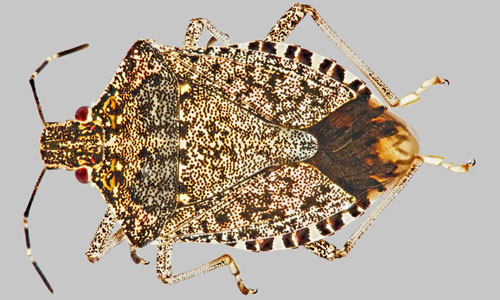Taking an environmentally sensitive approach to pest management
Brown Marmorated Stink Bugs in Homes
Published: October 11, 2016
By Jaime Pinero
Co-authored by Richard Houseman
The Brown Marmorated Stink Bug (BMSB) is a significant agricultural pest of foreign origin. It was first discovered in Missouri in 2013. Since then they have been slowly spreading throughout the state, mostly in the eastern (including St. Louis area) and the southern regions. In addition to causing damage to many types of plants and fruit in the spring and summer, BMSB becomes a nuisance pest both indoors and out when it is attracted to the outside of houses on warm fall days in search of protected, overwintering sites.

The adult BMSB is about 5/8 inch long, and marbled brown. It can be distinguished from other stink bugs of comparable size and color by the following characteristics: the antennae have two white bands, the legs are marbled brown with faint white bands; the membranous parts of the forewings have dark bands at the tip; and a banded abdominal edge is visible to the side of the wings.
Picture credit: Steven Valley, Oregon Department of Agriculture, Bugwood.org.
High numbers of BMSB result from the release of an aggregation pheromone (a scent that attracts other BMSB to the area). The aggregation pheromone is not the same chemical that causes them to stink. During the winter months BMSB enters a type of hibernation called diapause. During this time they do not feed and do not reproduce. The BMSB is the only stink bug known to congregate inside houses and other buildings the fall.
The Brown Marmorated Stink Bug is not harmful to people, houses, or pets. They do not bite, sting, suck blood, or spread diseases; and they do not eat or bore into wood structures. However, adults emit an offensive odor if disturbed or crushed.
Virginia Tech researchers developed an easy method to trap BMSB inside homes: (1) place a foil roasting pan filled with some water and a few drops of dish soap, (2) point a light into the pan, and (3) place the pan in an area where BMSB is present. Bugs will be attracted to the light and will fall into the water and drown. Empty the pan and repeat as necessary. See this short video produced by Virginia Tech.
(the link is https://vimeo.com/92354801)
Subscribe to receive similar articles sent directly to your inbox!
REVISED: November 1, 2016